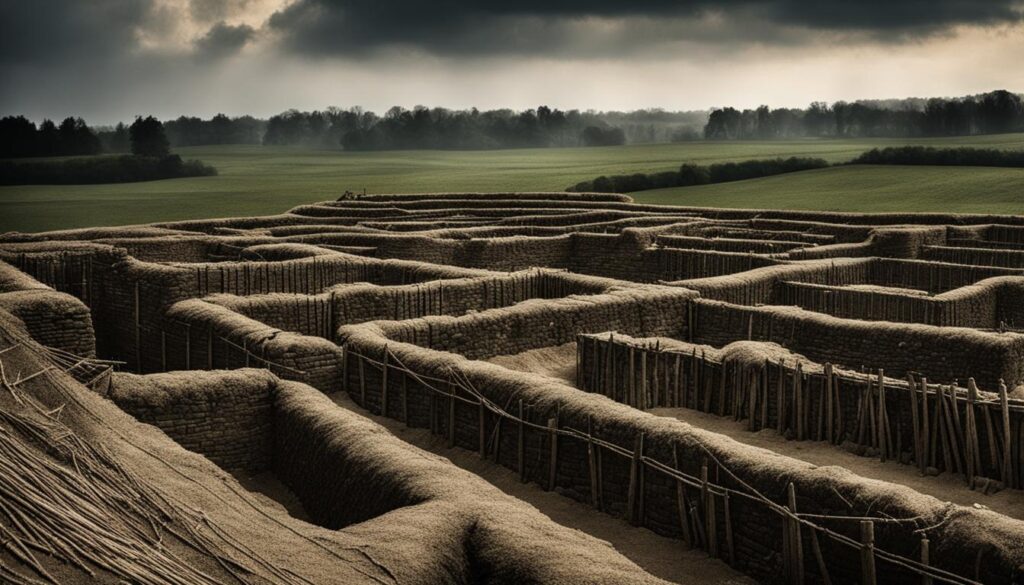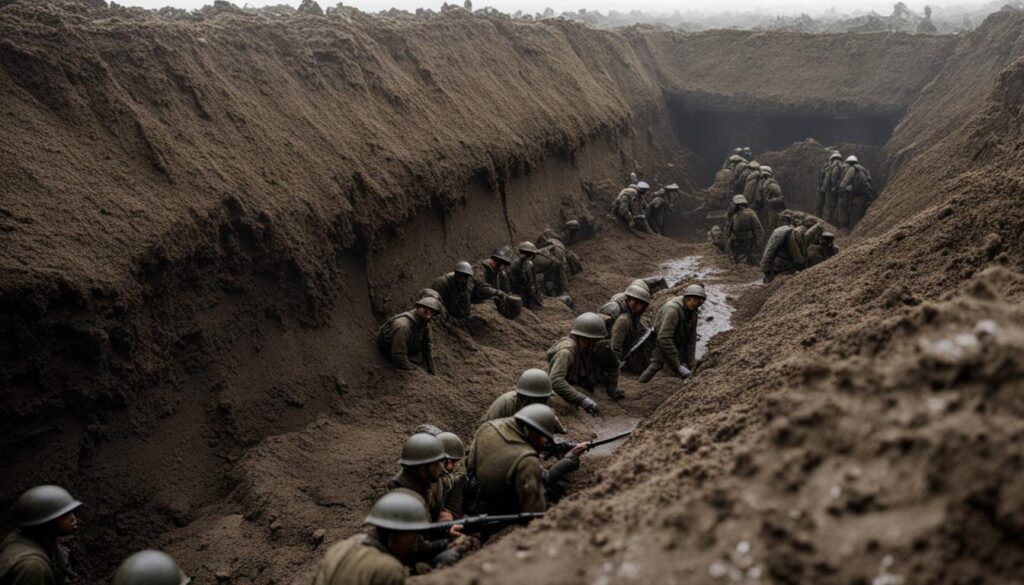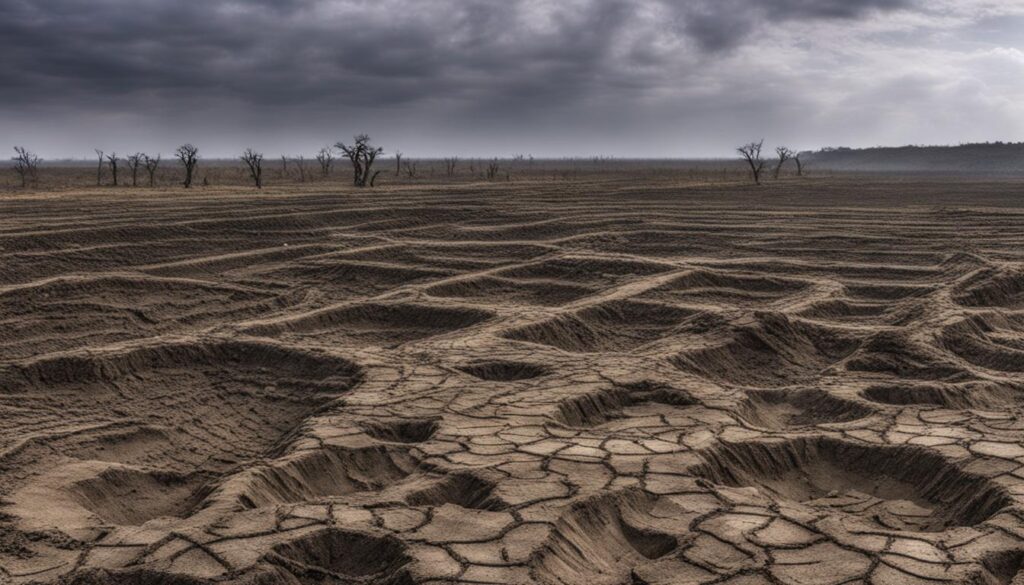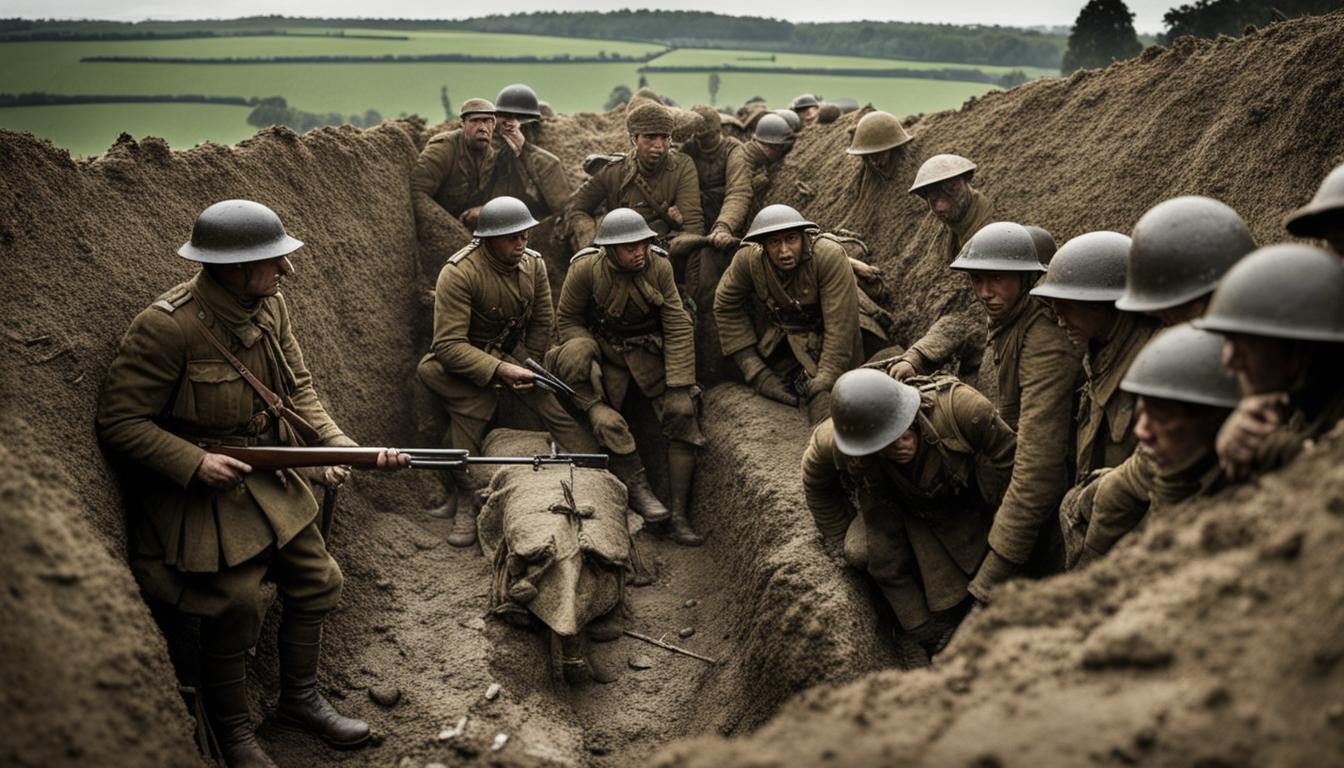Hello, readers! Today, I will take you on an immersive journey into the world of World War 1 trenches warfare. We will explore the intricate structures, the harsh conditions soldiers faced, the weapons and tactics employed, and the lasting impact of this form of warfare.
Trench warfare was a defining feature of World War 1, particularly along the Western Front. The extensive networks of trenches provided soldiers with protection from enemy fire, but life within these trenches was far from easy. The soldiers endured unsanitary conditions, constant danger, and the psychological toll of war.
Key Takeaways:
- Trench warfare characterized the fighting during World War 1, particularly along the Western Front.
- Trench systems consisted of front line trenches, support trenches, communication trenches, bunkers, and machine gun nests.
- Soldiers faced harsh conditions, diseases, and constant threat of death in the trenches.
- Machine guns, artillery, and poison gas were commonly used in trench warfare.
- Trench raids and patrols were employed for intelligence gathering and disrupting enemy lines.
The Structure of WW1 Trenches
Trench warfare during World War 1 was characterized by intricate networks of trenches that served various purposes. Understanding the structure of these trenches is crucial to comprehending the challenges faced by soldiers on the front lines.
Front Line Trenches
The front line trenches were the closest to the enemy and acted as the primary defense against enemy attack. They were typically about 8 feet deep and 4-6 feet wide, providing soldiers with some protection from enemy fire. Sandbags were used to reinforce the walls of the trenches, creating a more fortified position. Soldiers in the front line trenches had the constant threat of enemy snipers and artillery fire.
Communication Trenches
Communication trenches connected the front line trenches with the rear trenches and were crucial for the movement of troops and supplies. These trenches provided soldiers with safer passage between different areas of the trench system and were often more narrow and winding compared to the front line trenches. Soldiers used these trenches for transporting injured soldiers, delivering supplies, and relaying important messages.
Support Trenches and Bunkers
The support trenches were located behind the front line trenches and provided a secondary line of defense. These trenches were deeper and wider than the front line trenches and contained important infrastructure such as first aid stations, kitchens, and sleeping quarters. Additionally, there were underground bunkers strategically placed throughout the trench system. These bunkers served as storage areas for supplies, command centers, and provided protection for soldiers during heavy artillery bombardments.
Traverses and Machine Gun Nests
To avoid a straight firing line for the enemy, the trenches were not built in straight lines. Instead, they had alternating straight and angled sections known as traverses. These traverses provided additional protection and prevented enemy soldiers from having a clear line of sight down the trench. Machine gun nests were also strategically placed along the trench system to defend against advancing enemies. These nests were reinforced positions with machine guns that were used to suppress and repel enemy attacks.

Table: Trench Structure Overview
| Type of Trench | Description |
|---|---|
| Front Line Trenches | The closest to the enemy, about 8 feet deep and 4-6 feet wide. |
| Communication Trenches | Connect the front line trenches with the rear trenches. Used for troop and supply movement. |
| Support Trenches | Located behind the front line trenches, provide a secondary line of defense. Contains first aid stations and kitchens. |
| Bunkers | Underground storage areas, command centers, and shelters during artillery bombardments. |
| Traverses | Alternate straight and angled sections of trenches to prevent a clear line of sight for the enemy. |
| Machine Gun Nests | Strategically placed positions with machine guns to defend against enemy attacks. |
Conditions in the Trenches
Trench warfare during World War 1 subjected soldiers to extremely challenging conditions. The soldiers endured constant exposure to the elements, including rain, snow, and extreme temperatures. The trenches themselves were often waterlogged and filled with mud, making movement difficult and uncomfortable. This led to health issues such as trench foot, a painful condition caused by prolonged exposure to wet and cold conditions. Soldiers also suffered from frostbite and respiratory illnesses due to the unhygienic conditions in the trenches.
The unsanitary nature of the trenches exacerbated the health risks. Rats infested the trenches, carrying diseases and feeding on the decaying flesh of soldiers and animals. The soldiers had limited access to clean water and proper sanitation facilities, leading to the spread of diseases like dysentery and trench fever.
The constant threat of enemy fire and artillery bombardments added to the psychological distress experienced by soldiers in the trenches. The deafening noise from explosions and the fear of being killed or maimed created a constant state of anxiety and stress. The conditions in the trenches were unsanitary, uncomfortable, and psychologically challenging for the soldiers who endured them.

Impact on Soldiers
“Life in the trenches was a living hell. We were constantly wet, cold, and hungry. The mud and filth were unbearable, and the constant shelling made it impossible to rest. We lived in fear, not only of the enemy but also of the diseases that lurked in the trenches. It was a daily struggle for survival.”
- The soldiers endured constant exposure to the elements, including rain, snow, and extreme temperatures.
- The trenches were often waterlogged and filled with mud, making movement difficult and uncomfortable.
- Rats infested the trenches, carrying diseases and feeding on the decaying flesh of soldiers and animals.
- The soldiers had limited access to clean water and proper sanitation facilities, leading to the spread of diseases.
- The constant threat of enemy fire and artillery bombardments created a constant state of anxiety and stress.
Trench Warfare Conditions
| Condition | Impact |
|---|---|
| Mud and waterlogged trenches | Made movement difficult and uncomfortable, increased the risk of diseases like trench foot |
| Rats infestation | Carried diseases, fed on decaying flesh, increased the risk of infection |
| Unsanitary conditions | Spread diseases like dysentery and trench fever, contributed to poor health |
| Constant threat of enemy fire and artillery | Caused psychological distress and anxiety |
Weapons and Tactics in Trench Warfare
The nature of trench warfare during World War 1 necessitated the development of new weapons and tactics. Let’s explore some of the key elements that shaped the way battles were fought in the trenches.
Machine Guns
Machine guns played a crucial role in trench warfare. These weapons were highly effective in defending the trenches and suppressing enemy attacks. Operated by two to three soldiers, machine guns provided a significant advantage to the defending forces. They could deliver a high volume of fire, mowing down waves of enemy soldiers attempting to advance across No Man’s Land.
Artillery
The use of artillery was another essential aspect of trench warfare. Heavy field guns were employed to launch devastating barrages of shells at enemy trenches. These shells caused destruction, disrupt enemy defenses, and hindered their ability to mount an effective counterattack. The constant shelling created a hazardous and chaotic environment for soldiers on both sides.
Poison Gas
The introduction of poison gas was a particularly grim development in trench warfare. Chemical agents such as chlorine, phosgene, and mustard gas were deployed to incapacitate or kill enemy soldiers. Gas attacks were often preceded by the firing of gas shells, creating a cloud of toxic fumes that could drift into enemy trenches. Soldiers relied on gas masks to protect themselves, but the threat of gas attacks added a new dimension of fear and suffering to the already brutal conditions in the trenches.
In addition to these weapons, trench warfare also involved various tactics aimed at gaining an advantage over the enemy. Trench raids and patrols were conducted to gather intelligence, disrupt enemy lines, and boost morale. These operations required careful planning and coordination, often utilizing artillery and trench mortars to isolate specific sections of the enemy’s trench. Overall, trench warfare demanded a combination of weaponry, tactics, and strategic maneuvering to gain any ground in the static and deadly battlefield.
| Weapons | Tactics | |
|---|---|---|
| Machine Guns | Provided a significant advantage for defending the trenches and suppressing enemy attacks. | |
| Artillery | Heavy field guns launched barrages of shells to disrupt enemy defenses. | |
| Poison Gas | Chemical agents incapacitated or killed enemy soldiers. | |
|
Life in the Front Line Trench
Life in the front line trenches was a constant battle against the harsh realities of war. As a soldier stationed in the front line, I faced the relentless threat of enemy fire and artillery bombardments. The trenches were muddy, waterlogged, and infested with rats, making them uncomfortable and unsanitary. But amidst the hardships, we soldiers did our best to adapt and survive.
To protect ourselves from enemy fire, we constructed sandbag barriers along the trenches and built fire-steps, which allowed us to see over the top and keep a lookout for any signs of an enemy attack. This gave us a sense of security, albeit a fragile one. We also used duckboards to keep our feet out of the waterlogged trenches, although trench foot was still a common ailment.
“Life in the trenches was a constant struggle. The constant fear of death, the mud, the rats. It was a living nightmare. But we soldiers learned to rely on each other, to support one another in the face of unimaginable hardship.”
The psychological toll of living in the front line trenches cannot be understated. The constant exposure to enemy fire and the witnessing of the horrors of war took a heavy toll on our mental well-being. The noise from the artillery barrages was deafening and caused significant distress. We soldiers relied on each other for camaraderie and support, finding strength in our shared experiences.
Front Line Trench Conditions: A Comparison
To provide a better understanding of the conditions in the front line trenches, let’s compare them to the support trenches:
| Front Line Trenches | Support Trenches | |
|---|---|---|
| Sanitation | Poor | Relatively better |
| Proximity to Enemy | Closest | Further back |
| Comfort | Uncomfortable | Relatively more comfortable |
| Threat Level | High | Lower |
While support trenches offered some respite from the dangers and discomforts of the front line, life in the trenches, no matter the location, was a constant struggle for survival.
No Man’s Land
No Man’s Land was a treacherous and fiercely contested zone between the opposing trenches in World War 1. It was a barren and desolate area that soldiers on both sides fought to gain control of. This hazardous territory was often littered with barbed wire obstacles, craters from artillery bombardments, and booby traps, making it extremely difficult for soldiers to cross without detection. Venturing into No Man’s Land was a perilous task, as soldiers had to navigate through the obstacles while exposed to enemy fire and the risk of stepping on landmines.

In some instances, soldiers would conduct reconnaissance missions or small-scale attacks in No Man’s Land to gather intelligence or weaken the enemy’s position. These daring ventures required careful planning and stealth, as soldiers had to move quickly and silently under the cover of darkness. The goal was to gain valuable information about the enemy’s defenses or disrupt their lines, providing an advantage for future offensives. However, the risks associated with these operations were immense, as soldiers faced the constant threat of death and capture.
The significance of No Man’s Land cannot be understated. It represented the vast expanse of territory between the trenches where soldiers fought and died in the grim realities of war. It showcased the utter devastation caused by artillery bombardments and the challenges faced by soldiers on both sides. No Man’s Land became a symbol of the futility and sacrifice of war, a haunting reminder of the brutal nature of trench warfare.
The Challenges of No Man’s Land
Navigating through No Man’s Land was a daunting task for soldiers. The terrain, scarred by the war, was riddled with obstacles that hindered movement and provided cover for enemy snipers. Barbed wire entanglements, often several rows deep, posed significant challenges. Soldiers had to carefully cut through or find gaps in the wire to advance, all while being exposed to enemy fire. The risk of getting entangled in the wire or attracting attention from the enemy made traversing No Man’s Land a perilous endeavor.
The presence of landmines added to the dangers soldiers faced. These hidden explosives could cause severe injuries or death, making every step a life-or-death gamble. Soldiers had to exercise extreme caution, testing the ground with probing sticks or crawling slowly to avoid triggering a mine. The constant threat of being spotted and targeted by enemy snipers added another layer of peril to the already treacherous journey across No Man’s Land.
| Challenges of No Man’s Land | Solutions |
|---|---|
| Barbed wire obstacles | Cutting through the wire, finding gaps, using wire cutters |
| Landmines | Probing the ground, crawling slowly to avoid triggering mines |
| Enemy snipers | Moving quickly and silently, using cover and concealment |
Barbed Wire and Artillery
Barbed wire played a significant role in trench warfare. It was used extensively to protect the front line trenches and impede enemy advances. Multiple rows of barbed wire were laid, and breaks were strategically placed to allow soldiers access to No Man’s Land. However, many soldiers lost their lives by getting entangled in the wire and becoming easy targets for enemy fire.
Artillery was a crucial weapon in trench warfare. Heavy field guns were used to launch barrages of shells at the enemy’s trenches, causing destruction and disrupting their defenses. The constant bombardment created an environment of chaos and fear, often resulting in severe casualties for both sides. The sheer power and destructive capabilities of artillery made it a formidable weapon on the battlefield.
“The explosion of shells was deafening. The ground shook beneath our feet as the artillery bombardment continued. We huddled in our trenches, hoping the enemy’s shells wouldn’t find their mark. The taste of gunpowder filled the air, and the smoke obscured our vision. Artillery was the silent killer in trench warfare, raining death and destruction upon us.”
Table: Barbed Wire and Artillery
| Weapon | Description |
|---|---|
| Barbed Wire | Extensively used to protect trenches and impede enemy advances |
| Artillery | Heavy field guns used to launch barrages of shells at the enemy’s trenches |

Disease and Medical Conditions
Life in the trenches during World War 1 exposed soldiers to unsanitary conditions that contributed to the spread of various diseases. One of the most common ailments experienced by soldiers was trench foot. This condition was caused by prolonged exposure to wet and cold conditions, which led to severe pain, swelling, and tissue damage in the feet. The soldiers’ boots were often soaked with water and mud, and the constant dampness increased the risk of developing trench foot.
In addition to trench foot, soldiers in the trenches also faced the risk of other diseases. Trench fever, a bacterial infection transmitted by body lice, was prevalent among troops. This disease caused symptoms such as high fever, severe headache, and muscle pain. Dysentery, a bacterial or parasitic infection affecting the intestines, was another common illness in the trenches. It caused diarrhea, stomach cramps, and dehydration, further adding to the soldiers’ suffering.
Medical treatment in the trenches was limited due to the challenging conditions and lack of resources. Basic first aid stations were established in the support trenches to provide initial treatment for wounded soldiers. These stations often had medical personnel who would assess and stabilize the injured soldiers before they were transported to field hospitals for further care. However, the constant threat of infection and the limited resources available made it difficult to fully address the medical needs of the soldiers in the trenches.
| Disease | Symptoms | Treatment |
|---|---|---|
| Trench foot | Pain, swelling, tissue damage in the feet | Keeping feet dry, warm and elevated, regular foot inspections, changing socks and boots |
| Trench fever | High fever, severe headache, muscle pain | Rest, hydration, pain relief medication |
| Dysentery | Diarrhea, stomach cramps, dehydration | Fluid replacement, antibiotics, rest |
The Importance of Hygiene and Prevention
While medical treatment in the trenches was limited, preventive measures played a crucial role in reducing the risk of diseases. Soldiers were instructed to keep their feet dry and clean, changing socks regularly and applying anti-fungal powder. Maintaining personal hygiene, such as regular handwashing and disinfecting equipment, also helped reduce the spread of infections. Despite these efforts, the challenging conditions and close quarters in the trenches made it difficult to maintain optimal hygiene standards.
In conclusion, the unsanitary conditions in the trenches during World War 1 contributed to the spread of diseases such as trench foot, trench fever, and dysentery. While medical treatment was limited, preventive measures and basic first aid stations were in place to address the soldiers’ medical needs. However, the constant threat of infection and the lack of resources made it challenging to provide comprehensive care. The soldiers’ health and well-being were greatly compromised by the harsh conditions and diseases they faced in the trenches.
The Role of Patrolling and Raiding
In trench warfare, patrolling and raiding played crucial roles in gathering intelligence, disrupting enemy lines, and asserting dominance. Patrolling involved soldiers venturing into No Man’s Land, the highly dangerous area between opposing trenches, to monitor enemy activity and maintain a presence outside their own trenches. These patrols were essential for gathering information about the enemy’s position, strength, and intentions, helping commanders make informed decisions about future operations.
Raiding, on the other hand, was a more aggressive tactic used to disrupt the enemy’s lines and gather valuable intelligence. These small-scale attacks involved carefully planned and coordinated assaults on specific sections of the enemy’s trench. The aim was not only to cause casualties and damage, but also to capture prisoners for interrogation. By conducting successful raids, soldiers boosted morale within their own ranks while demoralizing the enemy.
Both patrolling and raiding required meticulous planning and coordination with artillery and trench mortars. By isolating specific sections of the enemy’s trench before launching an attack, soldiers could increase their chances of success. These operations were risky, as they exposed soldiers to enemy fire and the risk of stepping on landmines in No Man’s Land. Despite the dangers, patrolling and raiding were essential components of trench warfare, allowing for tactical advantages and psychological warfare.
Key Takeaways
- Patrolling involved soldiers venturing into No Man’s Land to gather intelligence and monitor enemy activity.
- Raiding was a tactic used to disrupt enemy lines, gather intelligence, and capture prisoners.
- Patrolling and raiding required careful planning, coordination, and the support of artillery and trench mortars.
- These operations were risky but essential for gaining strategic advantages and maintaining morale.
The Decline of Trench Warfare
Trench warfare, once the dominant form of warfare during World War 1, began to decline as new tactics and weaponry emerged on the battlefield. The static nature of trench warfare, with its elaborate network of trenches and fortified defense lines, proved to be vulnerable to new military strategies that focused on mobility and firepower.
One significant factor in the decline of trench warfare was the development of armored vehicles like tanks. These armored beasts were able to traverse the difficult terrain of No Man’s Land and break through enemy lines, effectively bypassing the static trench systems. Tanks provided a new level of mobility and firepower, making them a formidable force on the battlefield.
Similarly, the use of aircraft in warfare brought a new dimension to the battlefield. Bombers could target enemy trenches and disrupt defensive positions, while reconnaissance planes provided valuable intelligence about enemy movements. The ability to attack from the air forced armies to adapt their strategies and defense systems, rendering the static trench lines less effective.
In addition to the advancements in armored vehicles and aircraft, new tactics were developed that focused on infiltration and surprise attacks. Stormtrooper units were formed with the mission of infiltrating enemy trenches and disrupting their lines. These units employed rapid movement and small-scale attacks to bypass heavily fortified positions and create chaos behind enemy lines.
The Evolution of Warfare
The decline of trench warfare marked a significant shift in the way wars were fought. The static nature of trenches gave way to more dynamic and fluid forms of warfare, where mobility and firepower played crucial roles. The lessons learned from the trench warfare of World War 1 paved the way for the development of new tactics and strategies in subsequent conflicts.
“The decline of trench warfare marked a significant shift in the way wars were fought.”
While the legacy of trench warfare remains as a symbol of the brutal realities of war, its decline opened the door to new possibilities in military strategy and technology. The lessons learned from the hardships and challenges of trench warfare continue to shape the way wars are fought today.
Conclusion
Trench warfare was a defining feature of World War 1, particularly along the Western Front. It involved the use of complex networks of trenches that provided soldiers with protection but also subjected them to harsh conditions and constant danger. Trench warfare introduced new weapons and tactics, such as machine guns and artillery barrages.
Life in the trenches was challenging, with soldiers enduring unsanitary conditions, diseases, and the psychological toll of war. The decline of trench warfare came with the development of new tactics and weaponry that allowed for more dynamic forms of warfare. However, the legacy of trench warfare remains as a symbol of the brutal realities of war.
Trench warfare highlighted the need for continuous innovation and adaptation in the face of changing battlefield strategies. The lessons learned from this form of warfare laid the foundation for future military tactics and the development of more advanced weaponry. While trench warfare was a difficult and brutal experience for those involved, it shaped the course of war and left a lasting impact on the history of conflict.
FAQ
What was the purpose of the trenches in World War 1?
The trenches provided soldiers with protection from enemy fire.
How were the trenches structured?
The trench system consisted of front line trenches, support trenches, communication trenches, bunkers, and machine gun nests.
What were the conditions like in the trenches?
Soldiers endured harsh conditions, including exposure to the elements, mud, waterlogged trenches, rats, and the constant threat of enemy fire.
What weapons and tactics were used in trench warfare?
Machine guns, artillery, poison gas, and trench raids were some of the weapons and tactics employed in trench warfare.
What was life like in the front line trenches?
Life in the front line trenches was dangerous and challenging, with constant exposure to enemy fire and unsanitary conditions.
What was No Man’s Land?
No Man’s Land was the area between the opposing trenches, highly dangerous and contested.
How was barbed wire used in trench warfare?
Barbed wire was used to protect the trenches and impede enemy advances.
What were the common diseases in the trenches?
Trench foot, trench fever, and dysentery were among the common diseases in the trenches.
What role did patrolling and raiding play in trench warfare?
Patrolling and raiding were important for gathering intelligence and disrupting enemy lines.
Why did trench warfare decline after World War 1?
The development of new tactics and weaponry allowed for more dynamic forms of warfare.
Source Links
- https://www.historyonthenet.com/ww1-trenches-what-is-a-trench
- https://www.iwm.org.uk/learning/resources/fighting-in-the-trenches
- https://en.wikipedia.org/wiki/Trench_warfare

[…] the primary battleground during World War I, where the Allied and Central Powers engaged in brutal trench warfare. This grueling form of warfare was characterized by a network of trenches stretching across the […]